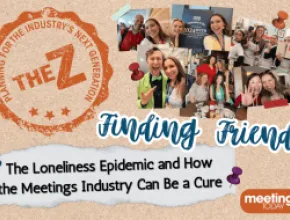NEW YORK
New research released by American Express Meetings & Events explores risk mitigation, including areas where lack of business controls, technology and operations around meetings and events can lead to diminished profits and fines from failure to adhere to regulatory requirements.
The whitepaper specifically focuses on the Life Science vertical, including Pharmaceuticals, Biotechnology / Biological Products and Health Care Equipment & Supplies, industries that are growing and rely heavily on meetings and events to connect and reach their stakeholders.
The whitepaper, titled “Protect Your Profits: Mitigating Meetings Risk in Life Science Companies,” surveyed leaders who oversee meetings activity as well as admin professionals who plan meetings and demonstrates the importance of risk mitigation as a company works to achieve education, awareness and expansion goals.
Key findings include:
- An impressive 70.1 percent of respondents agree their company has a formal meeting policy.
- However, according to respondents, crisis preparations guidelines only exist 60 percent of the time.
- Moreover, nearly one quarter of those surveyed do not know whether such crisis preparations guidelines exist at all.
“In order for companies to properly prepare for potential risk, planning ahead and establishing a meetings policy that adheres to regulatory requirements is critical,” said Issa Jouaneh, senior vice president and general manager, American Express Meetings & Events. “Our whitepaper explores top meetings management trends, including how companies are implementing tighter controls, embracing risk management techniques, evaluating risk levels and determining gaps in process and plans.
"At the same time, we found a disparity in views between meeting leaders who have direct or indirect responsibility for a meeting and those doing the actual planning. With this knowledge, companies can review their policies and determine the appropriate courses of action to minimize risks, balance the attendee experience and the focus on realizing the business objectives of their meetings and events.”
Tighter Controls
A documented, comprehensive meetings policy is a significant indicator of how tightly a meetings and events program is controlled. According to the whitepaper, 70.1 percent of leaders and administrators surveyed reported that their company has a formal meeting policy, a 26 percent increase from a multi-industry American Express Meetings & Events study, “Mitigating Risk in Meetings: Three Warning Signs of a Dangerous Divide Between Planners and Leaders”, conducted in 2013. The 2015 findings suggest Life Science companies have put in place tighter and more comprehensive controls than those of the broader corporate population.
Perhaps the most favorable news is that 92.3 percent of the administrative assistant planners in the whitepaper report that they use the policy that is in place. This could indicate that if processes and policies are in place and well-communicated and understood, then they are more likely to be followed.
Companies Too Confident?
Of those surveyed, 60.2 percent agreed that meetings and events risk is mitigated properly in their organization. However, 36.4 percent do not know if any type of legal, financial or procurement team has reviewed the meetings and events processes within the past year and another 22.9 percent are certain they have not had any such process reviews. Another 40.3 percent have had processes reviewed at least once.
Those who don’t know when the last review occurred are more prone to providing a neutral risk rating; those with no reviews tend to cite that they disagree that their company is following risk mitigation best practices. .
Mr. Jouaneh advised, “Companies should not be comfortable with even 90 percent of respondents agreeing risk is being mitigated properly. The stakes and penalties around non-compliance to industry regulations are very high. At American Express Meetings & Events, we help customers think about how to build a culture where meeting process diligence and regular review is paramount, particularly in many of the Life Science industries where there are additional complexities and requirements in play.”
Assistants are a Critical Variable
Administrative assistants across all types of Life Science companies spend a little over 25 percent of their time on meeting and event planning. In the Biotech sector, that percentage is slightly higher at 33 percent. According to the research, 54.2 percent of leaders report that more than half of their event planning is handled by administrative assistants as opposed to professional meeting planners.
Gaps in Process and Planning
Leaders and administrative planners alike recognize the importance of technology in meeting and event planning. Of those surveyed, more than half of respondents agreed that office applications are the most prevalent tools used for tasks such as budget management.
It is important to note that office applications, while easy to use, are static, making data retrieval of the information at a later date inefficient, time consuming, and less transparent. Meetings management software tracks, sources and manages meetings budget, registration and more to improve productivity, reduce errors from manual exercises and protect historical data.
As leaders and administrative planners underutilize technology, crisis preparedness and management continue to be challenging. Despite the fact that there appears to be more processes and controls in place around meetings and events, crisis preparation guidelines only exist 60 percent of the time and nearly 25 percent of respondents did not know whether such a guideline exists at all.
In investigating the types of resources that are available to leaders and administrative planners for crisis situations, 82.8 percent utilize standard operating procedures to track all meetings and events attendees.
AmEx Conclusion
It is typical to focus on generating savings and risk mitigation when companies and industries are under economic or regulatory pressures, but it’s important not to turn a blind eye when business is good and external pressure is less visible. Companies should take action now to ensure they have the right parameters in place to prepare for a time of expected business growth to ensure their meetings and events are a direct and compliant extension of their brand and corporate values.
Methodology
American Express Meetings & Events conducted this study January through March of 2015.
The study was designed as a two-dimensional survey of 274 responses: 156 Administrative Assistants who plan meetings as an element of their job and 118 Managers/Leaders who manage/oversee/have direct responsibility for the work that is accomplished.
The majority of total respondents, 38 percent, work in organizations with annual revenue up to $50M; 34.2 percent of respondents work in organizations with annual revenue between $50M to $1B; and 27.8 percent in organizations with $1B or more annual revenue. All respondents were based in North America.
Respondents were from Pharmaceutical companies (81.8 percent), Biotechnology/Biological products (7.3 percent), Health Care Equipment & Supplies (5.8 percent) with the remaining 5.8 percent from “other” Life Science Companies.
About American Express Meetings and Events
American Express Meetings & Events, a division of American Express Global Business Travel, offers longstanding experience, expertise and leading capabilities spanning program implementation to budget optimization to deliver powerful meetings and events experiences for clients.




